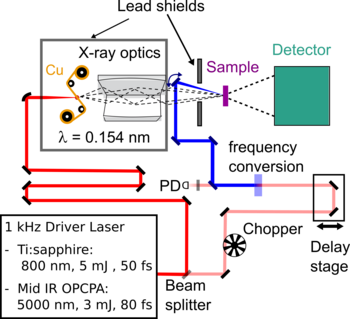T2: Femtosecond X-ray diffraction and absorption

The ultrafast diffraction experiments are based on the optical pump/x-rayprobe scheme illustrated in the figure to the left,where the sample is optically excited by sub 100 fs pulses of variable wavelengths. The resulting electronic dynamics are subsequently probed with hard x-ray pulses with a variable time delay between the two pulses.To eliminate temporal jitter, both pulses are derived for the same driver laser system. In one of our labs the driver laser is based on already well established amplified Ti:sapphire laser systems. In a second lab we are now implementing a new setup employing a novel mid IR OPCPA based driver laser developed at the MBI as part of project 4.1, capable to provided one order of magnitude more x-ray photons in the future. In both cases the laser pulses are focused on a moving copper target to generate hard x-ray pulses with a photon energy of 8.04 keV (Cu-Ka), a duration of roughly 100 fs, which can be diffracted from the excited sample in three basic types ofexperiments.

If the sampleis acrystalline powder this results in a characteristic set of Debye-Scherrer rings, which can be detected with a large area detector. This method, pioneered at the MBI, enables the determination of the transient changes of diffracted intensity for a large set of Bragg reflections simultaneously. These can then be used to retrieve the changes in the electron density upon excitation via the Maximum Entropy Method. In the case of a single crystal only a limited number of Bragg reflections are detectable for a stationary sample. The necessary number of reflections for a reconstruction of the transient electron density is then only accessible in a sequential fashion. To overcome this limitation, the rotating crystal method has been pioneered at the MBI allowing the fast and quasi-simultaneous measurement of a large set of Bragg reflections.